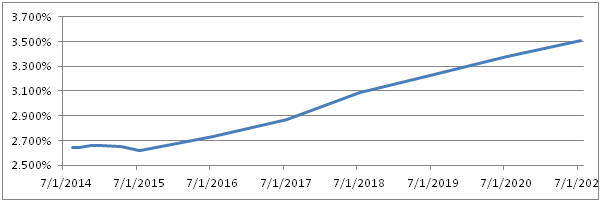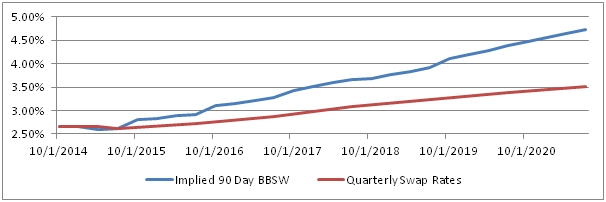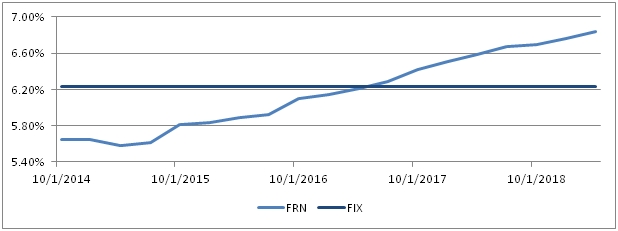Key points:
- One important misconception that investors often make is that swap rates are equivalent to the market expectation of forward BBSW rates. For floating rate notes to outperform, rates don’t just need to rise – they need to rise more than expectations
- Swap rates represent the weighted average of all the future BBSW rates out to that date
- Investors in Floating Rate Notes are required to forego income today in the hope of receiving greater income in future
One of the defining advantages of being a self-directed investor is that it gives you the opportunity to act on your personal view about markets, instead of just going along with the consensus.
Recently, we’ve had many clients, concerned about rising interest rates, express an interest in having a heavier weighting in their portfolio towards floating rate instruments instead of fixed. This can be a perfectly reasonable view to hold, however, we find that many clients instinctively underestimate the rate increases that are already priced into markets.
This article intends to highlight the key differences between fixed and floating rate instruments that investors need to be aware of in current markets.
First, whenever we’re talking about comparing fixed versus floating rates, we need to make sure that we remember how interest rate swaps work. At their heart the “swap rate” is the rate at which an investor is indifferent between accepting a fixed or floating rate of interest. For example, Monday’s five year quarterly swap rate was 3.23%. That means that if you give market participants the choice between being paid 90 day BBSW for five years, or being paid a fixed rate of 3.23%, they’d be happy taking either (see Figure 1).
Extended swap curve from Monday 28 July

Source: AFMA, Bloomberg
Figure 1
One important misconception that investors often make is that swap rates are equivalent to the market expectation of forward BBSW rates. Accordingly, they look at the five year swap rate, see that it’s at 3.23% and assume that means that the cash rate will be under that level. Not surprisingly, this makes them think that fixed rate bonds are expensive.In reality it’s a little more complicated.
Swap rates represent the weighted average of all the future BBSW rates out to that date. With some pretty easy maths, we can bootstrap what the implied forward BBSW curve is. For example, while the five year swap rate is at 3.23%, the implied 90 day BBSW rate in five years’ time is 3.91% - almost three full 25bps rate increases higher, or double as much over today’s 90 day BBSW rate than the swap rate is. Figure 2 shows the extended curve.
Swap Rates and Implied 90 Day BBSW Rates (as at Monday 28 July, 2014)

Source: AFMA, Bloomberg, FIIG Securities
Figure 2
The next important point to remember is the cashflow profiles of equivalent fixed or floating rate securities will look like over time. Let’s suppose that XYZ Corporation issued two five year bonds on Monday; a fixed rate bond paying five year swap plus 300bps and a floating rate note paying 90 day BBSW plus 300bps. Figure 3 shows the interest income that investors would expect to receive over the life of the investment.
Hypothetical XYZ Corporation fixed and floating rate interest income rates

Source: AFMA, Bloomberg, FIIG Securities
Figure 3
Not surprisingly, the fixed rate bond pays a steady coupon of 6.23% for the life of the bond, however, with the floating rate note, investors are required to forego income today (initially earning just 5.65%), in the hope of receiving greater income (up to 6.84% in the example) at the back end of the investment. It is important to note that it is just a hope – while there is certainty about both the income that the fixed rate bond will pay, and the fact that the floating rate note will pay a lesser amount of income initially, there’s no certainty about future payments on the floating rate note.
The actual amount of interest paid on the floating rate note has the potential to be either substantially more or substantially less than expected depending on where short term interest rate markets move. By way of example, Figure 4 shows the actual historical 90 day Bank Bill Swap Rate (BBSW) as well as the market implied expectations for forward BBSW rates from April 2012.
Extended swap curve from Monday 28 July
 Source: AFMA, Bloomberg, FIIG Securities
Source: AFMA, Bloomberg, FIIG Securities
Figure 4
The example in Figure 4 highlights that if an investor had bought a floating rate note in April 2012, the actual income they would have received would have been substantially less than the market’s expectations. Of course the opposite is also true (where rates could increase more than expected leading to a windfall gain), however, this demonstrates the benefit of the certainty that fixed rate instruments provide.
Conclusion
As many investors are expecting interest rates to rise, it can be easy to think that floating rate notes by definition represent a better option. This article has demonstrated that just because you expect rates to rise doesn’t mean that you should have a preference for floating rate notes – it wholly depends on whether you think that rates will rise more than markets are already expecting.
Importantly, when considering floating rate notes, investors should remember two key points:
1) Swap rates don’t represent future expectations of short term interest rate levels, but an average that’s weighed down by today’s low rates.
2) Floating rate note investments fundamentally require accepting a lesser return in the short term in the hope of higher returns in a future about which we cannot be certain.
Ultimately, considering these facts, I’m an advocate for a balanced portfolio among fixed, floating, and inflation linked notes which will protect me against a variety of uncertain future outcomes.
Copyright The contents of this document are copyright. Other than under the Copyright Act 1968 (Cth), no part of it may be reproduced or distributed to a third party without FIIG’s prior written permission other than to the recipient’s accountants, tax advisors and lawyers for the purpose of the recipient obtaining advice prior to making any investment decision. FIIG asserts all of its intellectual property rights in relation to this document and reserves its rights to prosecute for breaches of those rights.
Disclaimer Certain statements contained in the information may be statements of future expectations and other forward-looking statements. These statements involve subjective judgement and analysis and may be based on third party sources and are subject to significant known and unknown uncertainties, risks and contingencies outside the control of the company which may cause actual results to vary materially from those expressed or implied by these forward looking statements. Forward-looking statements contained in the information regarding past trends or activities should not be taken as a representation that such trends or activities will continue in the future. You should not place undue reliance on forward-looking statements, which speak only as of the date of this report. Opinions expressed are present opinions only and are subject to change without further notice.
No representation or warranty is given as to the accuracy or completeness of the information contained herein. There is no obligation to update, modify or amend the information or to otherwise notify the recipient if information, opinion, projection, forward-looking statement, forecast or estimate set forth herein, changes or subsequently becomes inaccurate.
FIIG shall not have any liability, contingent or otherwise, to any user of the information or to third parties, or any responsibility whatsoever, for the correctness, quality, accuracy, timeliness, pricing, reliability, performance or completeness of the information. In no event will FIIG be liable for any special, indirect, incidental or consequential damages which may be incurred or experienced on account of the user using information even if it has been advised of the possibility of such damages.
FIIG provides general financial product advice only. As a result, this document, and any information or advice, has been provided by FIIG without taking account of your objectives, financial situation and needs. Because of this, you should, before acting on any advice from FIIG, consider the appropriateness of the advice, having regard to your objectives, financial situation and needs. If this document, or any advice, relates to the acquisition, or possible acquisition, of a particular financial product, you should obtain a product disclosure statement relating to the product and consider the statement before making any decision about whether to acquire the product. Neither FIIG, nor any of its directors, authorised representatives, employees, or agents, makes any representation or warranty as to the reliability, accuracy, or completeness, of this document or any advice. Nor do they accept any liability or responsibility arising in any way (including negligence) for errors in, or omissions from, this document or advice. Any reference to credit ratings of companies, entities or financial products must only be relied upon by a ‘wholesale client’ as that term is defined in section 761G of the Corporations Act 2001 (Cth). FIIG strongly recommends that you seek independent accounting, financial, taxation, and legal advice, tailored to your specific objectives, financial situation or needs, prior to making any investment decision. FIIG does not make a market in the securities or products that may be referred to in this document. A copy of FIIG’s current Financial Services Guide is available at www.fiig.com.au/fsg.
The FIIG research analyst certifies that any views expressed in this document accurately reflect their views about the companies and financial products referred to in this document and that their remuneration is not directly or indirectly related to the views of the research analyst. This document is not available for distribution outside Australia and New Zealand and may not be passed on to any third party without the prior written consent of FIIG. FIIG, its directors and employees and related parties may have an interest in the company and any securities issued by the company and earn fees or revenue in relation to dealing in those securities.